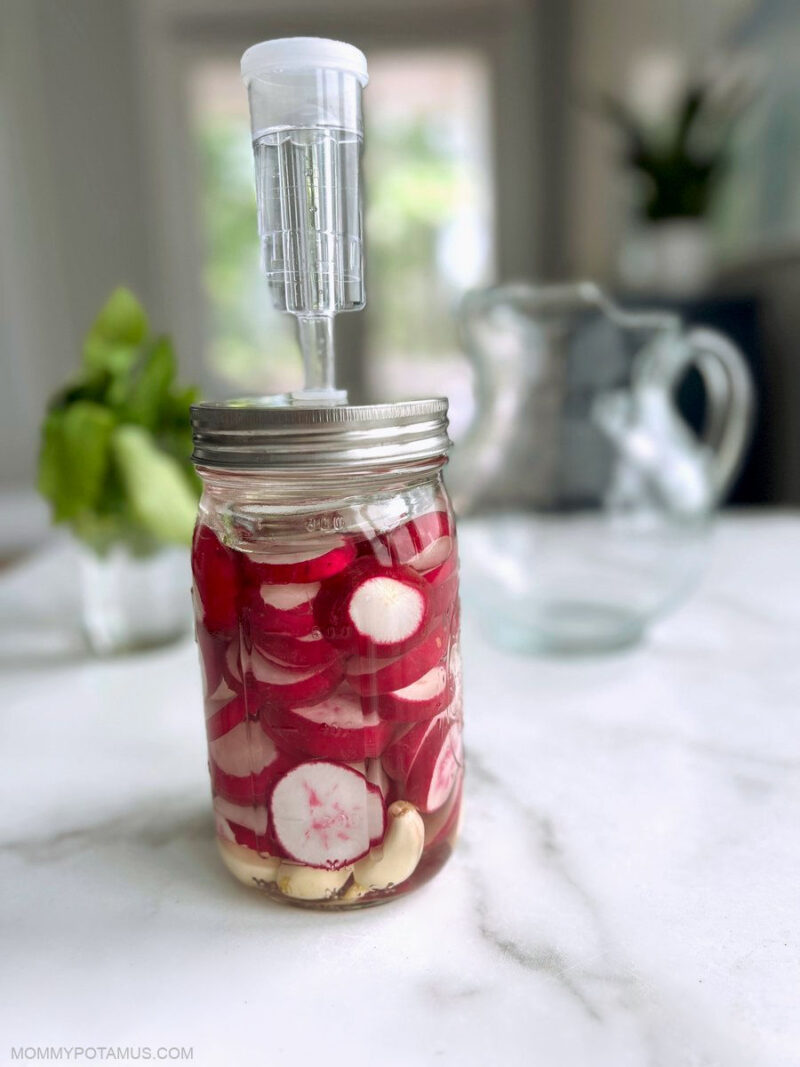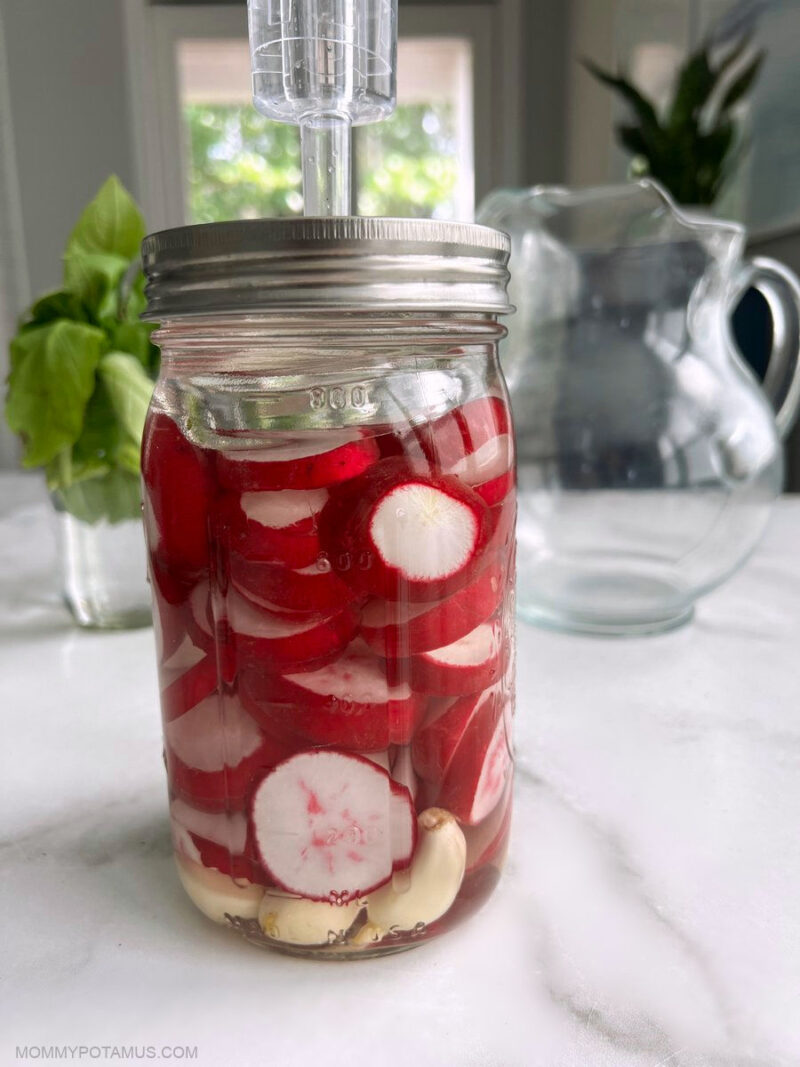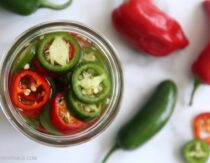
If you don’t love radishes, this recipe just might change your mind! Fermenting radishes takes some of the “bite” out of their flavor, replacing it with a crunchy, salty, slightly sour tang. My kids call them “radish pickles” and have been known to ask for second and third helpings . . . seriously!
They make a great addition to salads and charcuterie boards, and they can also be used as “chips” for things like hummus or ranch dressing.
Also, thanks to a process called lacto-fermentation, they’re rich in gut-friendly probiotics. Here’s how it works:
- Put veggies in a clean vessel.
- Add a saltwater brine to the vessel and seal it.
- Let the magic unfold.
By magic, I mean that lactobacillus bacteria – which are naturally present in veggies – are tolerant to saltwater, while most bad guys can’t take much of it. When we place veggies in a saltwater brine it gives the good guys the advantage, allowing them convert sugar and starches into lactic acid.
Other Benefits
Lactic acid is also helpful for:
- Improving the flavor profile (adding tartness/sourness)
- Extending the shelf life (lactic acid fermentation was one of the primary methods used to preserve foods for generations)
- Breaking down digestion inhibitors (oxalates and phytates) so that nutrients are more bioavailable. (1)
As a byproduct of fermentation, lactobacillus bacteria can also produce additional nutrients like vitamin K2, which are not naturally present in veggies. (2) So, in a nutshell, you get flavor, probiotics, improved digestibility, and additional vitamins.
What You’ll Need
To get started, you’ll need to gather your ingredients and some basic equipment like a wide-mouth quart jar and:
- An airlock lid that fits a standard wide-mouth mason jar OR a regular lid if you’re willing to “burp” the jar periodically (details in notes section)
- A glass weight to hold the radishes under the brine
Also, if your bunch came with the radish greens attached, don’t toss them – try this pesto recipe. Now let’s get to the recipe!

Lacto-Fermented Radishes
Equipment
- quart-size mason jar
- Fermentation weight*
- fermentation lid with airlock (optional)
Ingredients
- 3 cups sliced fresh radishes
- 2-3 whole garlic cloves (peeled)
- 3.5 tsp sea salt (non-iodized)
- 4 cups filtered water
Instructions
- Thoroughly clean your mason jar, lid, and cutting before getting started.
- Boil the water for five minutes, then measure out 3.5 cups of water and stir in the salt until it dissolves. Allow the brine to cool to room temperature.
- Place the peeled garlic cloves in the mason jar.
- Slice the radishes thinly and pack them into the fermenting jar, leaving about 1.5 inches of headspace between the top of the radishes and the lid.
- Pour the room temperature salt brine over the radishes until they are completely covered, leaving at least one inch of headspace between the top of the brine and the lid.
- Place a weight inside the mouth of the jar to keep your radishes under the brine. Place the lid on the jar and set up the airlock if you’re using one.
- Allow the jar to ferment at room temperature for 3-5 days, depending on how tangy you want them to be. Keep it out of direct sunlight – I keep mine in a shady area of my kitchen or one of my kitchen cabinets. Taste your fermented radishes starting on day 3, and when it reaches a flavor that you like transfer it to the fridge. If you're using a lid with an airlock, replace it with a regular mason jar lid before storing it.
Notes
Nutrition
More Fermented Vegetables To Try
Kimchi – Spicy and delicious, this simple kimchi recipe is a family favorite.
Fermented Carrot Sticks With Dill – Tangy and crunchy, these easy fermented carrots make a delicious snack or side dish for meals. Enjoy them plain or dipped in creamy homemade ranch dressing or onion dip.
Beet Kvass – This recipe is infused with ginger, which adds a pleasant flavor and also supports digestion.
Fermented Jalapenos – These “pickled” jalapeños are a total crowd-pleaser. Serve them on nachos, pizza, Mexican dips, salads, and more for a delicious pop of flavor.
Sources
- Nikhata, Smith G. et. al. (2018) Fermentation and germination improve nutritional value of cereals and legumes through activation of endogenous enzymes
- Liu, Yue (2019) Long-chain vitamin K2 production in Lactococcus lactis is influenced by temperature, carbon source, aeration and mode of energy metabolism







It’s from Pickl It, Whitt 😀 http://www.pickl-it.com/
I get a daikon thicker than my jars and push a slice down into the jar. I ferment Chinese fruit radishes and started rat tail radishes today.
We have been making these for several years just love them. My dad and my 2 year old son both gobble them up.
One tip for anyone without a weight is to add sliced carrots as a thick top layer. They don’t float and will hold the radishes down.
AWESOME tip, Zeffie! Thank you! My kids love these, too. Even more than pickles! 😀
nice!
Thanks for sharing! If someone is severely hypothyroid, how much radish should they consume/day?
Hi Sabiha! Honestly, I don’t really know. In my research I discovered that black radishes contain more raphanin than red radishes but there was no info on how the Russians determined dosages. I’m guessing it varied quite a bit from case to case.
This recipe sounds easy and delicious. One question, where did you get your weights? I’ve had issues in the past with food floating above the brine and cabbage leaves haven’t been a good fix…
Mine came with my Pickl It jar, but you can also use a boiled stone 😀
If you want a cheap alternative or want to make your own, this is the easiest DIY fermenting jar method Ive found online. I googled ”mason jar recap lids” and found a seller who shipped for free… the other parts you can get at a home brewing (beer) supply store. here’s a link to the DIY…
http://www.nwedible.com/2012/07/how-to-turn-a-mason-jar-into-a-fermenting-crock.html
Thank you, Stella! I love DIY stuff! 😀
Do Asian radishes – such as daikon or mooli – have the same compound? I love Gaktugi Kimchi!
I am SO glad I saw this recipe today. I am making it ASAP! I would love to know if there are other recipes you can share that are beneficial to thyroid health. Thanks so much!
Hi Sonya! There are many foods which are beneficial for thyroid function. I’ll share more as I learn, but one that cannot go without being mentioned is bone broth. You can read about the connection here: http://nourishedkitchen.com/the-benefits-of-bone-broth/
Fabulous! The only fermented veggie I’ve done so far is sauerkraut and I love having it on hand. I’m sure I’d love these as well. Radishes are just one of those veggies that I can’t eat much of. If they’re fermented, I bet they’re much easier to stomach!
I was so excited when I saw this thyroid healing recipe that I made it! Then I read this article http://www.thehealthyhomeeconomist.com/think-raw-veggies-are-best-think-again/ about how raw (even fermented) radishes (among other veggies) are actually harmful to the thyroids. There is so much conflicting info out there… just when I think I have something figured out it turns upside down. So, is it helpful or hurtful to the thyroids? Does anyone really know?
Ahhh, it is confusing! I can’t claim to have the final answer on this, Emily, but I’ll tell you my experience. This year is the first time I’ve had access to a farmers market in the fall, so it’s the first year I had access to fresh radishes. I’ve never been a huge fan of them, but I found all of a sudden that I LOVED them! I am tall and thin, which for some reason tends to be a body type that leans toward hypothyroidism, so I was concerned about the effect on my thyroid for the reasons you mentioned. That’s when I started digging and found the info about how it is used in Russia. I’d run across it before but only in passing, but this time I researched as much as I could. It is definitely a practice that has been used for a long time there, so I think it’s likely there’s something to it. However, if someone finds that they have an aversion to them I recommend not eating them! Aversions in cases like this may be the body’s way of telling us that a particular food – though not inherently harmful – is harmful to us. Every situation is unique!
A little late on this one but I had to get a good batch of radishes. Making this today and will be enjoying in a few days! Trying the carrot tip too to hold the radishes down. Thank you Mommypotamus!
People with hypothroidism should not eat foods in the mustard family (or should minimize their intake of these); which include cabbage & radishes. Here are two articles that talk about this: http://www.drweil.com/drw/u/QAA400441/Best-Thyroid-Treatment.html and “if you suffer from under active thyroid you should not use Horse radish at all. Actually this also applies to all plants from the “mustard” family, such as cabbage, radish and mustard itself.” http://www.herbalhealthinformation.com/herbal-health-information-on-horse-radish-amoracia-rusticana/
After the radishes have been transferred to the fridge how long do they stay good for?
Hi Mindy! I’m not exactly sure. If the lid is tightly sealed they should last at least a few months.
Could you just cover them with a clean towel and let the gases escape that way?
Could you just cover the radishes with a clean dishtowel and let the gases escape that way? Thanks.
no. you want to create an anaerobic environment. That means you don’t want oxygen in contact with the food. So you need a tight fitting lid. Preferably one that lets carbon dioxide escape. A cloth over the lid would allow way too much oxygen in and you will likely end up with spoilage.
Hi Heather, I LOVE your site and visit it often. I was eyeing up my overgrown radishes today, which have got out of control over Christmas as we went away camping. I was going to pull them out because they will be all hot and pithy. Do you think they may still be usable for this recipe?
Thanks for all your amazing work
Pamela
Hi Pamela! I’m not sure, sorry! If you give it a try please let me know how it turns out!
I made these radishes and I think they tase awful. How do I know if I made them correctly or if I just don’t like them? Thanks!
My husband and I made these the other day! I can’t wait to try them. However, my husband seems to think they are pickled rather than fermented. Any thoughts/feedback?
Thanks!
They’re fermented. This article explains the difference 🙂 http://www.thehealthyhomeeconomist.com/the-crucial-difference-between-pickled-and-fermented/
How long do these last?
Finally made these and they are SO yummy! I’m going to have to make a few more jars. These won’t last long.
Yay! So glad you like them, Natasha!
Have you ever fermented radishes with Whey? If so, it there a difference in bacteria strains? I’ve only fermented with whey once and some things I liked and some I didn’t at all. Looking for super fantastic recipes using whey. Thanks in advance.
I haven’t, sorry!
the bacteria in whey is the same bacteria as in a finished fermented product. The whey speeds the process along, but is not necessary. I like to use whey because when the process happens more quickly, it reduces the likelihood of things going bad.
Is it necessary to have an airtight seal while fermenting? I’ve seen some other recipes that just require a weight, but no cover or air tight seal to the jar. Just wondering if air would cause a problem to the fermentation process? Thanks for your help! Can’t wait to try these….
keeping the veggies completely submerged under a liquid, like the weight is doing, will create an anaerobic environment. It’s risky to do it this way, as opposed to a tightly sealed jar, because if any oxygen gets in contact with the veggie, like if they start to float on top of the brine, then the whole batch can be ruined by mold.
I’ve been fermenting quite a number of recipes over the years. However, I’ve not tried this one. Very tempted to try this as I find the radish/garlic combination interesting. Thank you for a nice site. Love your enthusiasm!
Ken
Hi!
Loved the post!
I have two questions: instead of using a weight can I just add more water to the jar to cover the radishes? And, have you ever tried not using garlick , does it taste good as well?
Hi, do you use hot or warm water? Thanks.
These turned out great! I halved the ingredients for a smaller jar. We liked the flavor after 6 days. This was my first attempt at fermenting, and we are just thrilled with the results- Thank you!!